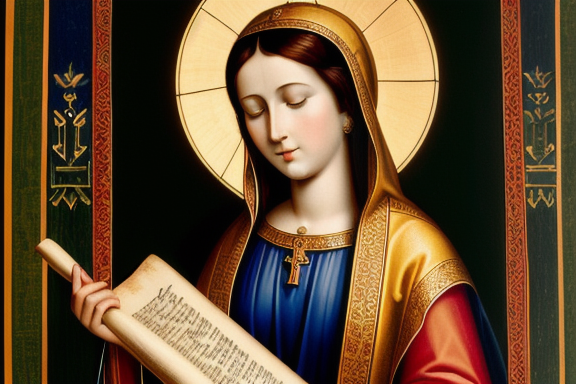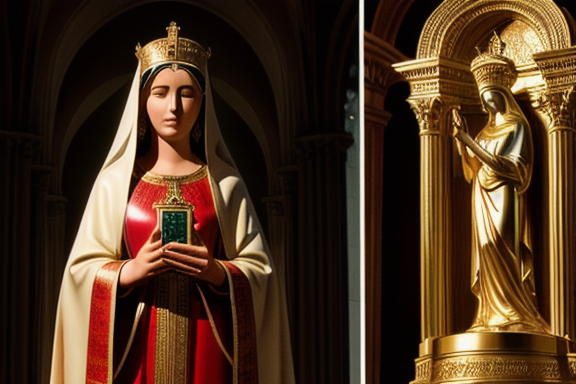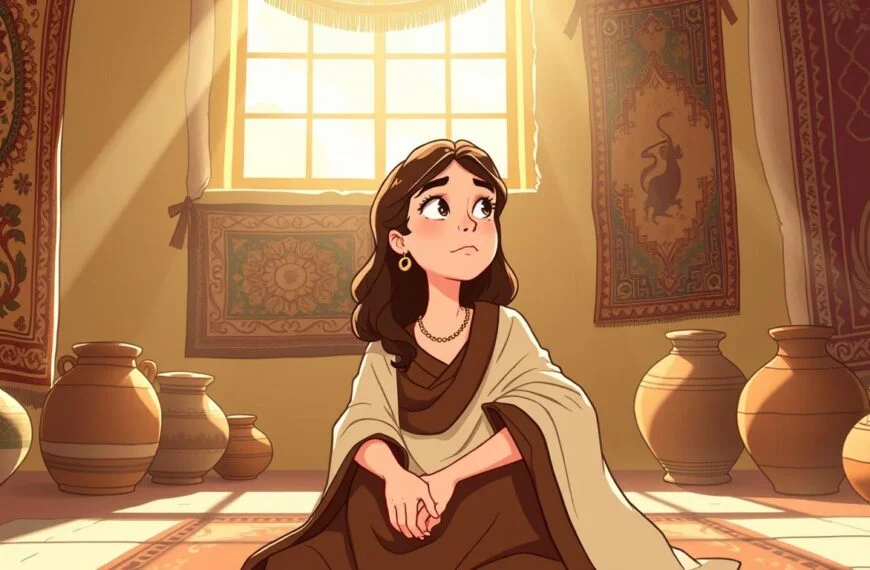When discussing the figures in the Bible, Mary is often associated with the New Testament as the mother of Jesus. However, her presence and significance can also be traced back to the Old Testament. Let’s explore Mary’s lineage, prophecies about her, her role in the story of Adam and Eve, and her presence in the book of Genesis.
Mary’s Lineage and Family Background
Mary’s lineage can be traced back to the tribe of Judah, one of the twelve tribes of Israel. She was a descendant of King David, which fulfilled the prophecy that the Messiah would come from the house of David. This lineage is highlighted in the genealogy recorded in the book of Matthew, connecting Mary to her forefathers and establishing her rightful place in the history of Israel.
Significance of Mary’s Name
Mary’s name holds deep significance in the biblical context. In Hebrew, her name is “Miriam,” which means “bitter” or “rebellious.” This name carries a profound symbolism as Mary played a crucial role in the redemption and salvation of humanity through her obedience and submission to God’s will. She became a vessel for God’s grace and mercy, bringing hope and sweetness to a world plagued by sin.
Prophecies about Mary in the Old Testament
The Old Testament contains several prophecies that foreshadowed the coming of Mary and her role in God’s plan. One notable prophecy is found in Isaiah 7:14, where it is foretold that a virgin shall conceive and bear a son, whose name shall be Immanuel. This prophecy points to the miraculous conception of Jesus through the Holy Spirit in Mary’s womb. Another prophecy in Micah 5:2 predicts that the Messiah would be born in Bethlehem, the city of David, further linking Mary’s lineage to the fulfillment of God’s promises.
Mary’s Role in the Story of Adam and Eve
In the book of Genesis, we encounter the story of Adam and Eve, the first human beings created by God. Through their disobedience, sin entered the world, leading to the separation between humanity and God. However, God did not abandon His creation. In Genesis 3:15, God pronounces a curse on the serpent and declares that the offspring of the woman will crush the serpent’s head. This prophecy hints at Mary’s role as the mother of Jesus, who would ultimately defeat the power of sin and restore humanity’s relationship with God.
Mary’s Presence in the Book of Genesis
While Mary’s name may not explicitly appear in the book of Genesis, her presence can be inferred through the symbolic imagery and foreshadowing found within its stories. For instance, the story of Noah and the ark can be seen as a prefiguration of Mary, as the ark served as a vessel of salvation for Noah and his family, just as Mary became the vessel through which God brought salvation to humanity. Additionally, the story of Abraham and Isaac’s sacrifice foreshadows the sacrifice of Jesus on the cross, in which Mary played a significant role as the mother who witnessed her son’s ultimate sacrifice.

Mary in the New Testament
Continuing from the rich history of Mary in the Old Testament, we now turn our attention to her remarkable presence in the New Testament. Mary plays a pivotal role in the life and ministry of Jesus, from his miraculous conception to his crucifixion and resurrection.
Mary’s Miraculous Conception and Birth of Jesus
The New Testament introduces us to Mary as a young woman who receives a divine visitation from the angel Gabriel. In the Gospel of Luke, we learn that the angel announces to Mary that she has been chosen by God to conceive and bear a son, who will be named Jesus. This conception is no ordinary one, as Mary conceives through the power of the Holy Spirit, making her pregnancy miraculous.
Mary’s faith and obedience shine through as she humbly accepts this incredible task, uttering the famous words, “Behold, I am the servant of the Lord; let it be to me according to your word” (Luke 1:38). Mary’s unwavering trust in God’s plan marks the beginning of her extraordinary journey as the mother of Jesus.
Mary’s Journey to Bethlehem for the Birth of Jesus
As the time for Jesus‘ birth draws near, Mary and Joseph embark on a journey to Bethlehem, Joseph’s ancestral town, to comply with the Roman census. This arduous journey, undertaken while Mary is heavily pregnant, demonstrates her resilience and determination.
Upon arriving in Bethlehem, Mary and Joseph find no room in the inn, and Jesus is born in a humble stable. The birth of Jesus in such humble circumstances underscores the humble beginnings of the Savior, who would later bring hope and salvation to the world.
Mary’s Role as the Mother of Jesus
Mary’s role as the mother of Jesus extends far beyond his birth. She nurtures and cares for him, providing a loving and supportive environment for his growth. As Jesus grows in wisdom and stature, Mary witnesses his miraculous works and teachings.
One notable incident that highlights Mary’s presence during Jesus’ ministry is the Wedding at Cana. When the wedding party runs out of wine, Mary turns to Jesus for help. In response to her request, Jesus performs his first public miracle, turning water into wine, demonstrating the special bond between mother and son.
Mary’s Role in the Crucifixion and Resurrection of Jesus
Perhaps one of the most poignant moments in Mary’s life is witnessing the crucifixion of her beloved son. Standing at the foot of the cross, Mary demonstrates unwavering strength and faith, enduring immense heartache as Jesus willingly gives his life for the salvation of humanity.
After Jesus’ crucifixion, Mary also plays a significant role in the early Christian community. She is present with the disciples in the upper room when the Holy Spirit descends on the day of Pentecost, empowering them for their mission to spread the Gospel.
In conclusion, Mary’s journey in the New Testament is filled with incredible moments of faith, sacrifice, and love. Her unwavering devotion to God’s plan and her pivotal role in the life and ministry of Jesus make her a revered figure in Christianity. As we delve deeper into the biblical narrative, we discover more about Mary’s remarkable character and her enduring legacy.
Mary’s Role in Christian Tradition
In Christian tradition, Mary holds a significant role as a symbol of purity and devotion. She is revered and venerated in various Christian denominations for her exceptional virtues and her unique role as the mother of Jesus. Mary’s unwavering faith, humility, and obedience to God’s will make her an inspiring figure for believers around the world.
The veneration of Mary is a practice that can be traced back to the early days of Christianity. While the degree of veneration varies among different denominations, Mary is highly regarded and honored as the Theotokos, the Mother of God, in Eastern Orthodox, Roman Catholic, and some Anglican traditions. Through prayers, hymns, and devotions, believers express their love and gratitude for Mary’s intercession and seek her guidance and protection.
Mary’s apparitions and miracles have been reported by numerous individuals throughout history. These extraordinary events have further deepened the devotion to Mary. From the famous apparitions at Guadalupe, Lourdes, and Fatima to lesser-known ones, these encounters are believed to be divine manifestations of Mary’s presence and messages for humanity. Many pilgrims visit these holy sites seeking spiritual solace and healing.
The role of Mary in intercessory prayer is a significant aspect of her veneration. Mary is seen as a compassionate and powerful intercessor who can bring prayers to her son, Jesus. Many believers turn to Mary, entrusting their needs, hopes, and sorrows to her loving care. Through her intercession, they seek comfort, spiritual guidance, and the grace of God.
Mary’s representation in art and iconography is a rich and diverse tradition. Throughout centuries, artists have depicted Mary in various forms, capturing her maternal tenderness, grace, and devotion. From iconic paintings like Leonardo da Vinci’s “The Virgin of the Rocks” to sculptures, mosaics, and stained glass windows, Mary’s image is a source of inspiration and contemplation for believers and art enthusiasts alike.

It is important to note that while Mary holds a significant place in Christian tradition, her role is always understood in relation to Jesus. She is revered as the mother of the Savior and a faithful disciple who exemplifies the virtues of faith, obedience, and love. Through her life and example, Mary continues to inspire believers to deepen their relationship with God and strive for holiness.

Rockin’ the faith, one verse at a time!
Growing up, the Bible’s stories deeply impacted me. Now, with over 15 years of preaching experience, I blend timeless teachings with modern technology, making them relevant for today’s world.
Bible Hub Verse is my platform to share historical insights and thought-provoking articles, exploring both familiar and uncommon Christian topics. My passion is building a welcoming online space for everyone to learn, grow in their faith, and discover the Bible’s enduring message.
Join the journey!
God bless you.





